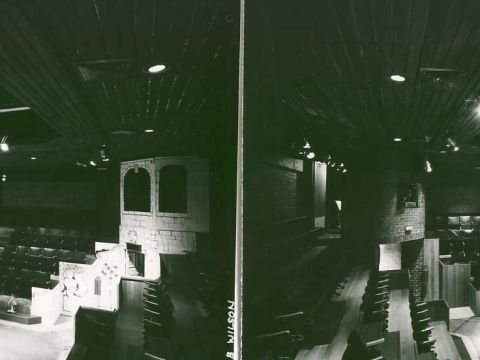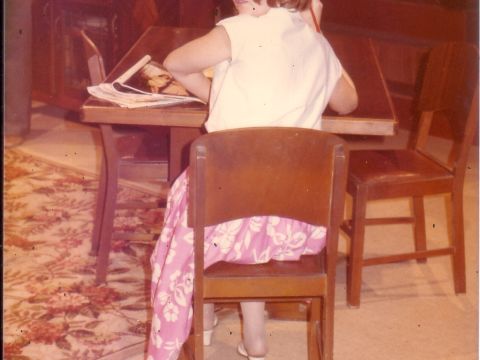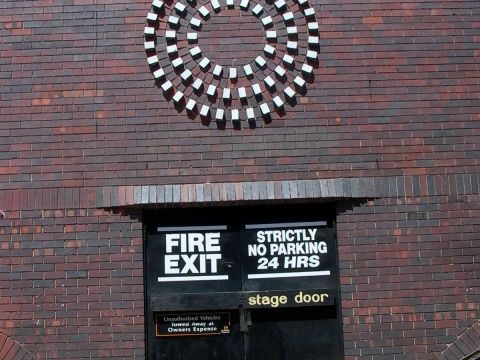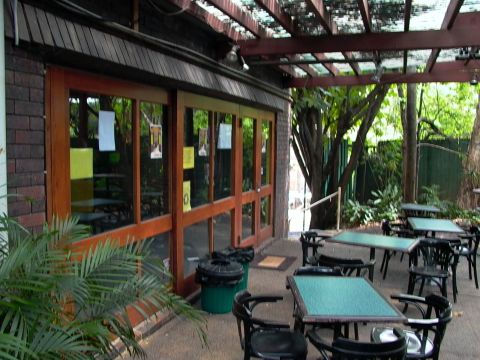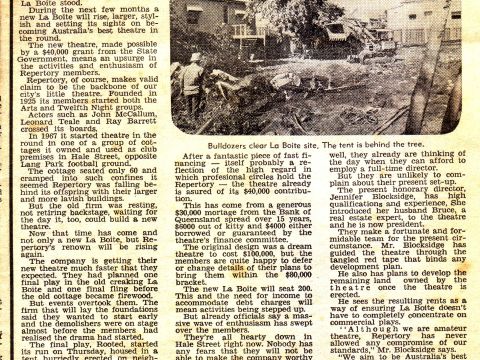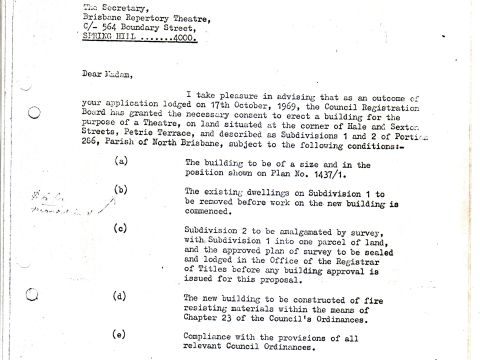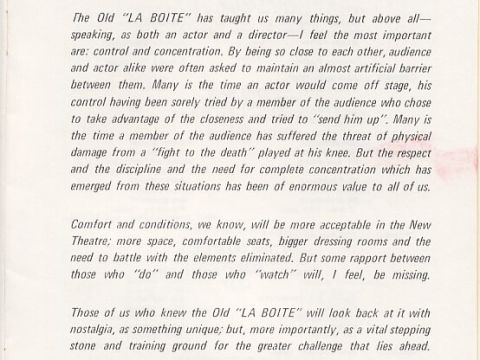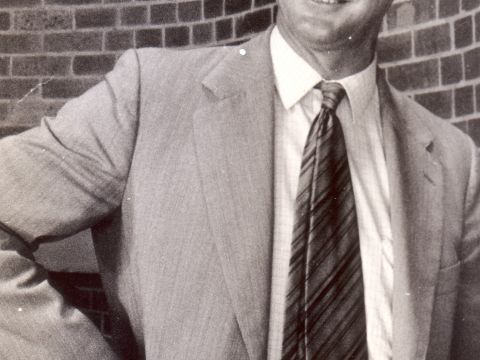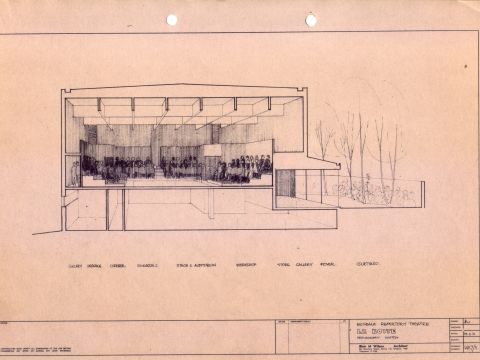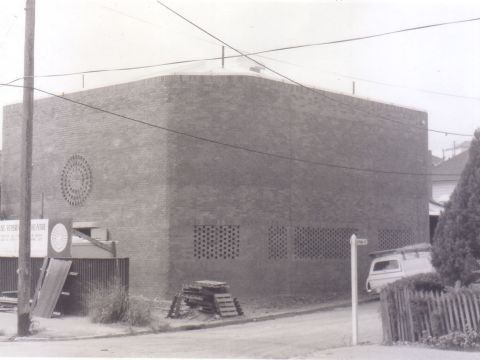Our History
La Boite Theatre Opens in 1972

The purpose-built La Boite theatre officially opened on Sunday June 4, 1972.
La Boite Theatre in the 1970s
It was an extraordinary achievement for an amateur Brisbane theatre group in the early 1970s to build a purpose-designed theatre-in-the-round. It was a first for Australia - and a bold move to then christen it with a fancy French name! But Brisbane Repertory had never lacked confidence.
When it outgrew the 70-seat converted cottage – the first La Boite – Theatre Director Jennifer Blocksidge envisioned a new style of theatre building to meet La Boite’s evolving needs. Excited by the New Wave of Australian playwriting igniting Sydney and Melbourne, she wanted Brisbane to join the action, ideally in a new building designed for innovation and alternative theatre.
The plan for an architect- designed, modestly budgeted 200 seat theatre-in-the-round became a reality in 1971 with a generous Queensland Government subsidy. Architect Blair Wilson and his company headed the project and the new La Boite Theatre opened on 10 June 1972 with a gala performance of an Australian play, Rodney Milgate’s A Refined Look at Existence directed by Jennifer Blocksidge and starring Bille Brown.
Theatre critic Katharine Brisbane commented on what “an interesting space” it was, describing it as: “… literally a ‘box’. The arena is square, with steeply raked seating and gives a satisfying feeling of being enclosed in the same space as the characters and their problems, while at the same time being securely above them. This makes for an excellent play-audience relationship.” (The Australian, September 8,1972).
Indeed, the engaging architectural configuration provided an unusually intimate relationship between actor and audience. It was this subjective power of the iconic building, the inclusive nature of the performing space for both audience and artists that contributed to its strong cultural identification in Brisbane.
The new theatre, built on the site of the first La Boite, was constructed on three levels. Entered from Hale Street via the stage door, level one incorporated dressing rooms, a large work-room, small kitchen, office space, and toilets; level two, the front entrance of the building, was entered via Sexton Street and comprised the box office, foyer, and courtyard; and level three (accessed via a circular-shaped flight of stairs from the foyer) contained the auditorium with central stage, tiered seating on four sides with flexibility to remove one bank of seating, and an elevated sound and lighting box.
For his brick, concrete and timber design of La Boite Theatre, architect Blair Wilson was awarded the 1972 Clay Brick Award for the creative use of the distinctive dark bricks. Both he and Bruce Blocksidge were subsequently awarded the Theatre’s highest honour of Life Membership for their roles in the planning and realisation of this unique Australian theatre building.
Although no longer operating as a theatre, the building will always hold special memories for the many thousands associated with its 30 years of exhilarating theatre activity.
Background to the new theatre and La Boite’s unprecedented development in the 1970s
Newly appointed Theatre Director Jennifer Blocksidge and her then husband Council President Bruce Blocksidge emerged as the change agents of this period of unprecedented development. Their combined vision for a radical new theatre building and very contemporary programming catapulted La Boite to national attention by the mid-1970s. Yet the Blocksidges (like the Stephens) were very much part of the Brisbane establishment, well known as senior members of the Queensland Liberal Party and of the Brisbane Anglican Church. These connections may well have made the difference when La Boite applied for government funding for their new building and were successful in obtaining a $40,000 subsidy to be matched dollar for dollar by the theatre. Another paradox would seem to be Jennifer Blocksidge herself. Although trained in the English theatre tradition (she was English born and bred) , she was excited both intellectually and artistically by the explosive cultural shift in Australian theatre that was well under way by 1970 with the New Wave generation of playwrights, directors and actors. Taking a tough-minded approach, she imposed a new artistic vision that was aimed at making La Boite a part of this new theatrical territory. That La Boite had outgrown its 70 seat makeshift theatre and a new purpose-built theatre in-the-round was planned gave Blocksidge the opportunity for a fresh beginning.
The Gala Premiere Performance in the presence of the Vice Patron Hayes Gordon of the non-naturalistic Australian play, A Refined Look at Existence to open the new theatre was a strong indicator of the direction Jennifer Blocksidge intended to take La Boite. In her program notes, she signalled that audiences could expect to see more and more Australian plays in future seasons:
Theatre has been the “orphan” art of Australia. Today there is a growing awareness of the importance of “doing our own Theatrical Thing” rather than relying on the label “It’s good – it’s imported”. Hopefully, Repertory Theatre will be part of this awareness. The atmosphere and size of La Boite should lend itself well to this sort of venture.
In its first season, the new Australian smash-hit from Nimrod Street Theatre, Biggles by Michael Boddy, Marcus Cooney and Ron Blair brought to the new La Boite stage a rougher, more larrikin style of theatre that found great favour with younger audiences. The first play to be performed in the thrust, the sexually explicit The Chapel Perilous by Dorothy Hewett was so popular that it had an extended season.
There is no doubt that the opening of this new theatre was a most significant accomplishment of the La Boite Council and its Committees of the time. Hardly had it begun operations however, before two issues surfaced that would worry successive La Boite Councils for several decades. In Brisbane’s words, La Boite soon became ‘the place to go to in order to see the red meat of theatre’[i]. Older members in particular didn’t want to see ‘red meat’ and didn’t much like the new preference for Australian plays many of which they considered crude and outspoken. The second issue was the tension between La Boite’s amateur status and the desire of professional directors and actors to work in this exciting and versatile performance space.
Yet this did not derail Jennifer Blocksidge’s artistic policy to produce challenging plays from contemporary world theatre and the best new Australian plays that she could obtain rights for. She was proud of the fact that six of the ten major plays in her 1974 seasons were Australian[ii]. Most controversial was Jack Hibberd’s Captain Midnight V.C. directed by guest director Lindsay Smith which Blocksidge described as “a production that provoked violently opposed comment – ‘shocking waste of good talent’ was one, and ‘the most exciting theatre in years’ was another”[iii].
Just as risky was the demanding, but much praised A Stretch of the Imagination by Jack Hibberd, directed by Bruce Knappett with Barry Otto playing Monk. Yet another ‘first’ in 1974 was the beginning of a La Boite trend to foster Queensland writing: the production of Jill Shearer’s play The Trouble with Gillian was the first time a new, full-length work by a Queensland writer had been premiered in the new La Boite . In 1975 Nick Enright’s production of Edward Bond’s Saved “provoked one of the most interesting nights in the theatre’s history”[iv]when dozens of people, led by a group of fifty Lions Club members, walked out during the violent stoning of the baby scene. It was this embracing of innovation, experimentation and risk (alongside enough sure-fire box office successes to keep the theatre economically viable) that contributed to La Boite’s growing reputation in Brisbane and nationally as an alternative theatre company.
Although La Boite was neither financially nor philosophically ready for professional status, Jennifer Blocksidge’s vision was for professionalism in the fullest sense. In fact, the journey towards professionalism began in 1973 with the appointment of an Executive Officer and continued in 1975 with the foundation of La Boite's Early Childhood Drama Project, the first professional theatre-in-education team in Queensland for this age group. At the beginning of 1976, professionalism came one step closer with Jennifer Blocksidge’s decision to resign as Honorary Theatre Director and the realisation of her dream, the appointment of La Boite’s first salaried Artistic Director, Rick Billinghurst, considered at the time as “one of Australia’s most talented theatre directors”[v].
Writer: Christine Comans
#Gallery
#Have any photos to share?
We'd love to see your photos and publish them in our archive.
#Tell us your story
To save costs, Blair Wilson used defect bricks from the local brickwork's. So dump trucks would offload the bricks and the brickies would paw through them to select the likely bricks to use (that weren't too misshapen) and chuck the rest.
After Blair won the award, the price of reject bricks went through the roof and were being manufactured specifically as "defects". So Blair brought the "defect brick" style to Brisbane.


